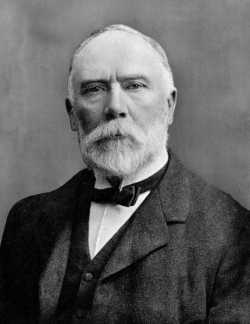Sir James Mackenzie 1853-1925

Sir James Mackenzie (Courtesy of Wellcome Library, London)
Sir James Mackenzie was undoubtedly the key figure in shaping British cardiology. Born at Pictstonhill Farm on the outskirts of Scone, he trained in medicine at Edinburgh University and became a general practitioner in the industrial mill town of Burnley in Lancashire. Recognising at an early stage the lack of understanding of the basis and prognostic significance of symptoms and signs that he came across in his everyday work, he set out to investigate these through prolonged and careful clinical observation of large numbers of patients and repeated analysis of their records.
His main interests were cardiovascular disease in general and cardiac failure in pregnant women in particular. To aid him in the analysis of heart beat irregularities he made pulsation recordings. Initially done with a modified Dudgeon sphygmograph that allowed him to record on smoked paper venous and arterial pulsations simultaneously, this was followed later by his own invention, the multi-channel ink-writing polygraph.
In 1902, after 28 years of single-handed painstaking observations and recordings, Mackenzie published the results in The Study of the Pulse. This book was pivotal in the development of cardiology and by this time he had undoubtedly become the world clinical authority on the heart.
Because Mackenzie had not at that time received the acclaim in his own country that was being afforded to him from overseas, he moved to London in 1907 in order to expound more fully the radical views that he held. He published his definitive work The Heart the following year, and in 1913 was appointed Physician in Charge of the first cardiac department in the UK at the London Hospital. Here he gathered together and inspired men such as Thomas Lewis and John Parkinson, both of whom were later knighted.

Dudgeon Sphygmograph DUNUC 4005
Mackenzie's other achievements included the bringing of objectivity and measurement to the understanding of cardiac irregularities, in particular showing the harmless nature of extrasystoles and sinus arrhythmia, and rationalising digitalis therapy. He is perhaps best known for his recording of the disappearance of the 'a' wave of atrial contraction from the jugular pulse and the pre-systolic murmur of mitral stenosis with the onset of what he recognised as 'atrial paralysis', later to be identified as atrial fibrillation.
In response to a desperate plea from the War Office, Mackenzie and Lewis set up a study at Mount Vernon Hospital in Hampstead on the so-called 'soldiers' heart', where assessment concentrated on functional efficiency of the heart rather than the presence of supposed or dubious anatomical lesions. This led to re-definition of the disorder as 'effort syndrome' and allowed thousands of men to be declared fit for active service.

The Mackenzie Polygraph DUNUC 4266
Mackenzie had suffered from cardiac pain since 1908 - he was 'case 28' in his own book Angina Pectoris, published in 1923. He died shortly after developing severe cardiac pain whilst at a Burns supper in London. In accordance with his wishes, his heart was removed by his loyal assistant John Parkinson and sent to David Waterston, Professor of Anatomy at St Andrews, who with the help of D F Cappell, Professor of Pathology in Dundee, wrote up the pathological description in the British Heart Journal.
Back to exhibition homepage